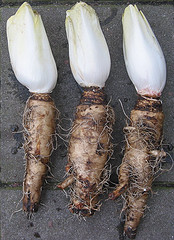Chicory
| Infobox on Chicory | |
|---|---|
| Example of Chicory |  |
| Freshness facts | |
| Optimum carrying temperature | 0°C |
| Highest freezing point | -0,5°C |
| Acceptable product temp. at loading into containers | Max. 2°C above carrying temperature |
| Optimum humidity | >95% |
| Ventilation setting for containers | 0 m³/hr |
| Storage life | 2-4 weeks |
| Climacteric / non-climacteric | Non-climacteric |
| Ethylene production | Very low |
| Ethylene sensitivity | High (russet spotting) |
| Modified / controlled atmosphere | 3%-4% O2; 4%-5% CO2 |
| Potential benefits | Good |
| Availability | |
| On demand | |
Chicory
Contents
Harvesting and Handling
The edible portion of chicory (or Belgium endive) is the young, enlarged, compact and etiolated terminal bud that is composed of young leaves and the partially suppressed, but enlarging floral stem. In the trade, this product is called a chicon. The chicon results from the forced growth of an apical bud from the defoliated and vernalized root. The roots are harvested after a first year of grown in the field, partially defoliated except for the apical bud, and stored until ready for forcing. Belgian endive is a popular vegetable in northern European countries and is available year-round because excellent storage capabilities of roots harvested for subsequent forcing permits chicon production throughout the year.
A high quality chicon will be compact with turgid closely overlapping outer leaves having a milky white appearance and a tinge light yellow colour on leaf margins. The chicon should feel heavy for its size. Leaf tips should not curl back, and the base should be will-trimmed perpendicular to the upright axis, without discolouration. Chicon shapes should be lancelolate, with the length ranging from 2-3 times the maximum width. Development of green leaf colour is a quality defect.
Additional quality criteria require that chicons should be sound, free of reddish blemish, frost damage or traces of bruises, disease, insects, parasites or rodent attack. Quality is also decreased by flower stem development in excess of three fourths of the bud’s length. The butt end should be flat, well trimmed with a fresh appearance and free of abnormal exterior moisture and odours. Extra category chicons are uniformly shaped, meet appropriate size dimensions, have outer leaves that measure at least half the chicon length, are firm, and do not exhibit greening or a glassy appearance. Lesser quality involves less uniformity, less favourable appearance, deterioration, and loss of compaction.
Elevated temperatures during holding and retail presentation are the major contributor to product greening, even more than that attributed to exposure to light.
Chicons are often packed in perforated plastic film bags, or film overwrapped trays. Packing perforations are intended to limit condensation, since moisture on the chicons is detrimental to maintaining quality. Bags are opaque or covered with opaque blue or green paraffin paper in order to minimize moisture loss and to exclude light. Chicons must be handled with care to avoid mechanical damage to minimize discolouration and pathological problems.
Cooling and Storage
Conventional room-cooling is the most commonly used method for pre-cooling.
The recommended conditions for commercial storage of chicons are 0°C with 95% to 100% RH and light excluded. At 2°C, favourable storage for 2 to 4 weeks can be expected before significant deterioration. At 5°C, the period is reduced to 1 to 2 weeks, and 1 week or less at 15°C.
Temperature has a greater influence on greening than does light. At 0°C there is little or no greening, even in the presence of light, but as the temperature rises, the incidence of greening increases. Chicory is not chilling sensitive, but freezing at -0,5°C must be avoided.
Controlled atmosphere considerations
Storage-life in air can almost be doubled by storage in 3% to 4% O2 + 4% to 5% CO2 at 0°C. CA storage delays greening of leaf tips in light and leaf spreading.
Storage disorders
Alternaria spot, Anthracnose, Downy mildew, Grey mould rot, Powdery mildew, Watery soft rot.











